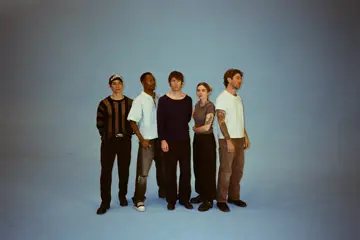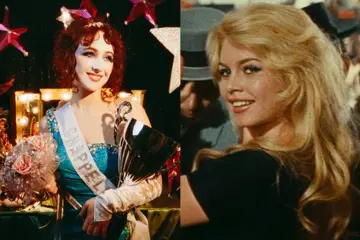In last week's MIFF preview edition of this award-winning film column, amidst an unending barrage of trailers, yr ol' pal Film Carew confessed that the recommendin' of Holy Motors was on rep only: I hadn't actually seen it. But a week is both a long time in football and pre-festival-movie-bingeing, and, oh, now, how things have changed. How I've seen Holy Motors in all its glory. It's just the fifth feature for the iconoclastic French auteur Léos Carax —coming 13 years after his 'troubled' Pola X— and certainly the first to find such fond, buzz-film-ish critical favour. And, programmed into the forthcoming Melbourne International Film Festival, it's bundled with a retrospective of Carax's career thus far; a suite of strange, lyrical, ridiculous, romanticised style-pieces that've been barely seen in this country.
Holy Motors is certainly Carax's most crowd-pleasin' effort, an absurdist comedy of obtuse vignettes that owes an obvious historical debt to Chaplin and Tati, yet is stylised with a grotesque excess of colour that puts it in the league of Matthew Barney's Cremaster cycle or Tsai Ming-liang's The Wayward Cloud. It's a film that essentially avoids synopsisin', but, roughly: longtime Carax muse Denis Lavant plays a chameleonic actor whose clock-punching job involves playing out a host of perverse roles for, we assume, an unseen audience. They make for oft-comic short-films, and the meta-theatricality of them is obvious: Lavant cavorting through one role in a motion-capture suit; literally chewing the scenery as a grotesque beast (Mr. Merde, a character revisited from Carax's section (alongside Michel Gondry and Bong Joon-ho) in the Tokyo omnibus); or being drawn into musical numbers sung by a trench-coated Kyle Minogue or played by an accordion-wielding army drawn from a Vincent Moon Take-Away Shows video. Even when the fiction creates an impressive emotional 'truth' —like a scene where Lavant plays a proud father shamed by his daughter's neurotic shyness— there's no realness here; every new 'job' bookended by scenes of applying and removing make-up, wigs, wardrobes et al. It seems to be a fairly obvious commentary on the unreality of the modern era, where whole generations play out their prescribed existences like method actors; making Holy Motors, within the MIFF program, a thematic companion not just to Carax's catalog, but to Yorgos Lanthimos's Alps. This them is underlined in a scene where when Lavant, lamenting his dwindling love-for-the-job to his interloping boss (Michel Piccoli), talks of how the vanishing of cameras —how technology has receded from gargantuan film cameras to invisible digital surveillance— has removed the apparatus of performance, to the point where there's neither in-front-of or behind the camera anymore. Yet, there's a telling —transformative— moment when Piccoli's bossman surmises his own paranoia like this: “I've always been sure I'd die some day”; as if the thought borders on insanity. Soon, the suggestion spirals out into a bizarre fact of this world: here, there is no death, only immortality; and slain doppelgangers rise and move on to the next job as soon as they've expired. You could read this anyway you want; but to me it suggests that, in the surveillance-state era of constant performance, the world has become cinema itself; everyone immortal, living on forever in stored memory, second-party virtuality, and the captured image. Thus, with no death knocking, the powerful in this realm watch performances of death —stabbings, shootings, old age, dramatic suicide leaps— with pornographic relish. With no end and no beginning, no fiction and no reality, no sense of mortal righteousness or closure, the world of Holy Motors swims as dreams-within-dreams-within-dreams: as fluid and elusive, as untenable and inscrutable, as the subconscious. Carax manages to make his film feel both free-form and fucked-up, yet precise and meticulously-scripted; his descent into the uneasily unreal a pitch-perfect piece of stylised auteurism.
Holy Motors feels like the culmination of Carax's craft, but it's hardly an evolutionary step; the French filmmaker arrived fully-formed, and with his own idiosyncratic style from day zero. He made his first feature, Boy Meets Girl, when he was just 23, and it's an astonishing feat for someone so young: a work of visual inventiveness and staggered storytelling whose evocations of the nouvelle vague —its black-and-white stock, its jump-cuts, its communities of artful urchins looking at the Parisian landscape through their own fantastical view— don't actually make it play like a new-wave film; there nothing serendipitous or ad-hoc in his magnificently-staged tracking shots and pull-aways, in his succession of joyous images after joyous images. It marked the start of Carax's 'Alex Trilogy' a series of films that posed Lavant as the central character; a lonesome urchin who's throttled by a seizing feeling of love. The MIFF retrospective impishly bills its subject as The Last Romantic; and seeing Juliette Binoche chasing after a teenaged, motorycle-ridin' Julie Delpy in his dystopian sci-fi parable Bad Blood or soaking in Binoche and Lavant pirouetting through wild sprays of exploding fireworks in Lovers On The Bridge (which was Lovers On The Pont-Neuf back when I saw it, but that's another story), you get that sense of wild romanticism, that way that emotion becomes motion; Carax's flights of visual fancy —and his lovelorned leaps into the dramatic extremities of the musical— mirroring his protangonists' escape into the surreal delirium of love.
There's a wild, transformative sequence in 1999's Pola X, Carax's most divisive, disliked film. Though its budget was 'reared back' from that of Lovers On The Bridge, Carax's fourth film was, just like its predecessor, a financial flop in France; a work of wacky excess and deranged vision that didn't find much of a willing audience. The film is the auteur's oblique adaptation of Herman Melville's infamous disaster-of-immorality, Pierre; or, The Ambiguities, and it starts out playing like any other translation of classic-lit to screen: all verdant lawns, white-linen wardrobe, manor house mannerisms, and ostentatious wealth. Yet, when the story takes a turn towards Greek tragedy —with incest unknowing, knowing, and accidental dogging its hero— suddenly the film leaves behind its soap-operatic colour-palette and plunges into a forest at night; descending into a darkness that swallows the whole, unexpected second act. With hyper-theatricality, the wealthy scion of the piece reinvents himself as hardbitten author; which involves shacking up in an industrial warehouse where a group of cultural terrorists diligently rehearse an avant-garde opera (penned by Scott Walker!) day and night. Their revolutionary zeal reminds the idealistic writer of his desire to peel away the polite façade of society, to reveal "the grand lie hidden behind everything," a noble crusade that turns grimly ironic when he uncovers the scandalous secrets behind his own family's history. Pola X is far-and-away Carax's most extreme, hysterical, and least-likable picture; but there's a grandeur in its madness; and, as always, there are images —a mascara-streaked Catherine Deneuve on a motorcycle at night, hair blowing out behind like a fluttering flag— that feel transcendent.
Don't miss a beat with our FREE daily newsletter
Watching Carax's career —just five films in 30 years— in close proximity reveals the many motifs and recurring images that thread through his work: silent films as framing device; characters struck by cars; a beaten man staggering through the streets barely able to stand; Lavant tumbling like an acrobat or bumbling through Chaplinesque burlesque; the twinkling of Parisian lights; trains throttling through subways; musical moments both MGM-ish and bracing. His films all have the same kind of air: each a wild melodrama conforming to no known narrative logic; their glorious images all steeped in the symbolist strangeness of the subconscious. “My dreams sent me,” Binoche says, in Lovers On the Bridge; attesting that dreams drive her reality, that they have command over her by demanding the debt of explication: she must reunite with her lost lover because he's been in her dreams. This feels like Carax's metier: he, too, is driven by his dreams; and the burden they place upon him is bringing them to bear —in all the delirious, wondrous, wacky visions— on screen.














